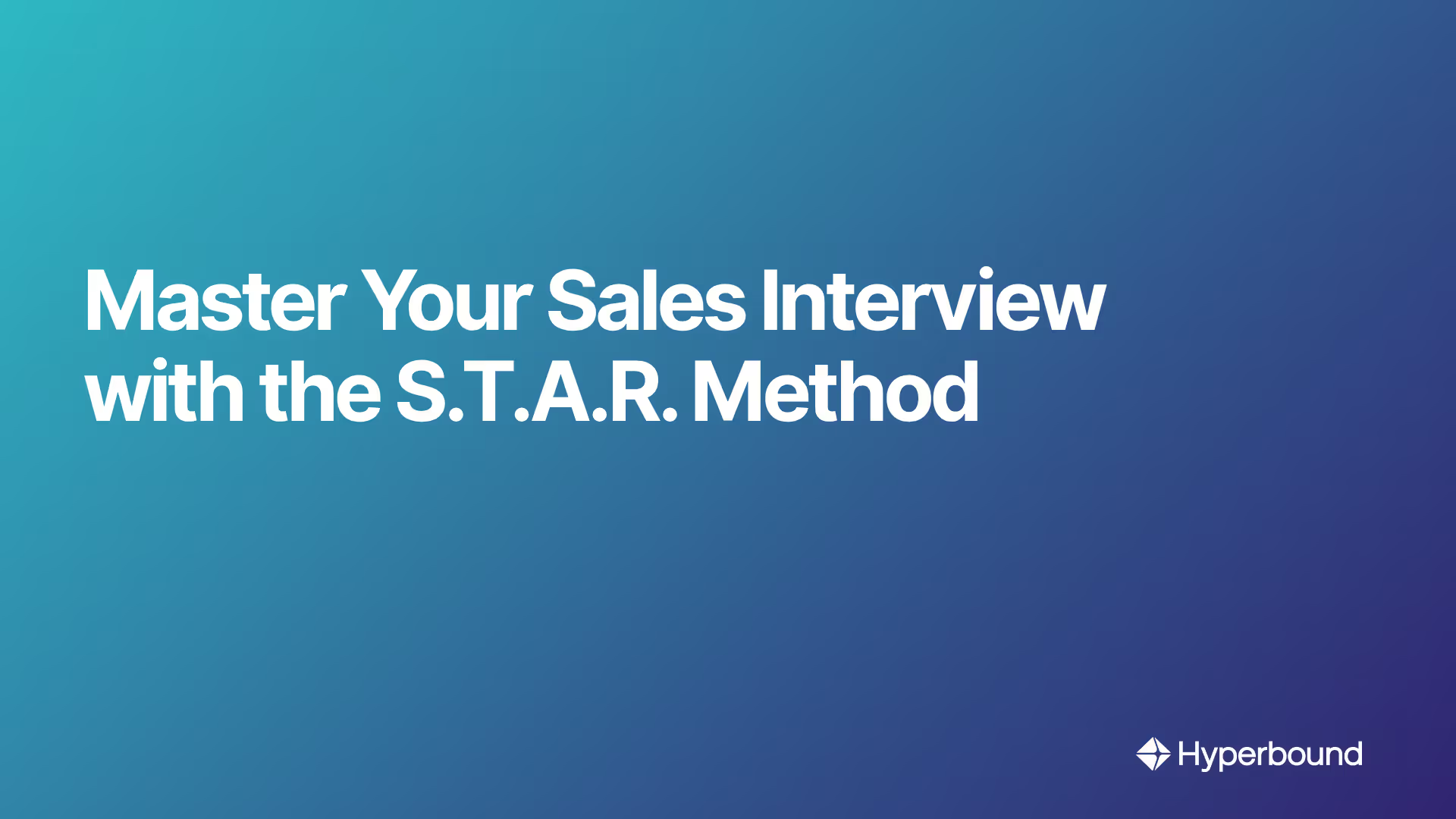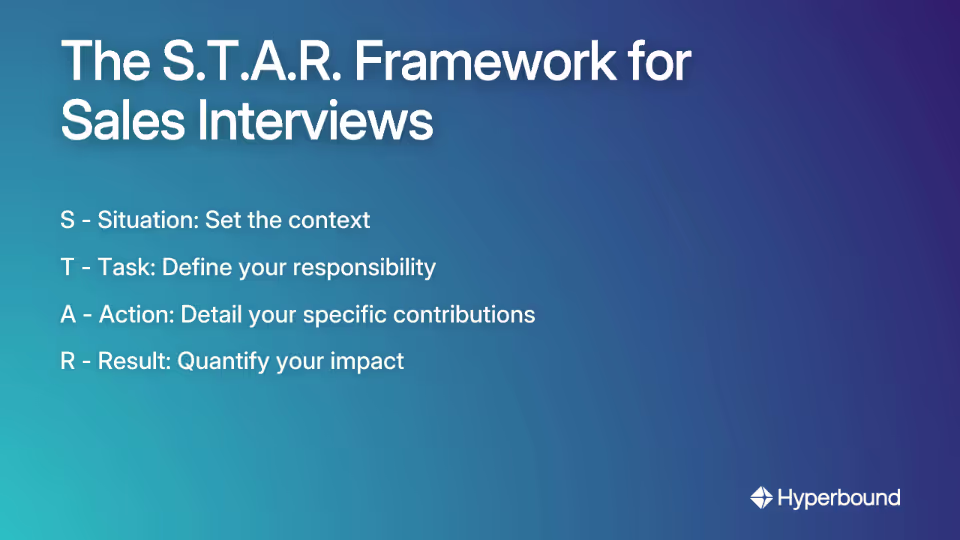
You've landed a sales interview - congratulations! But now you're feeling that familiar mix of excitement and anxiety. Will you ramble when answering questions? Can you effectively communicate your value? Will your enthusiasm matter, or is it all about checking boxes on the job description?
If you've ever felt your interview answers meandering without direction or struggled to articulate why your experience matters, you're not alone. As one sales professional put it, "There's a tremendous difference in a structured answer and one that is just rambling."
Here's the truth: Hiring managers don't just want a list of your skills; they want compelling evidence of how you've applied them. They approach your answers with a "so what?" mindset, needing to understand why your experience should matter to them.
Enter the S.T.A.R. method – your secret weapon for transforming scattered thoughts into powerful, structured narratives that demonstrate your value. This widely-recognized framework isn't just useful for sales interviews; as industry professionals note, "Not just sales - but any job - it's always good to know and be familiar with the S.T.A.R. Answer method."
In this article, we'll break down the S.T.A.R. method step by step, providing concrete examples tailored specifically for sales roles. You'll learn how to craft compelling stories that showcase your expertise, demonstrate your growth mindset, and ultimately help you close the deal on your dream sales position.
What is the S.T.A.R. Method? Breaking It Down for Sales Professionals
The S.T.A.R. method is a structured technique for responding to behavioral interview questions – those questions that ask you to provide specific examples of past behavior. It stands for Situation, Task, Action, and Result, creating a narrative framework that transforms your experiences into compelling stories.

Here's how each component works:
S - Situation
Set the scene and provide context for your story.
What to include: Describe a specific challenge or opportunity you encountered. Keep it concise—just two or three key details. This could be from a previous sales role, a client interaction, or even a relevant experience outside of work.
Tip: This should be the briefest part of your answer. The interviewer is more interested in your actions and results than extensive background.
T - Task
Explain your specific responsibility or objective in that situation.
What to include: Clearly define what you needed to accomplish. Were you tasked with closing a difficult client, hitting an aggressive sales target, or resolving a customer complaint?
Tip: This section should also be brief, setting the stage for the most important parts – your actions and the results they produced.
A - Action
Describe the specific steps you took to address the task.
What to include: This is the most detailed part of your answer. Outline the one to three key actions you took. Use strong action verbs and focus on your discovery questions and the qualitative research you conducted to inform your approach.
Crucial Tip: Use "I" statements, not "we." The interviewer wants to know about your contribution, not the team's. This is where you build your personal branding.
R - Result
Share the outcome of your actions.
What to include: Explain what happened, what you accomplished, and what you learned that contributed to your growth mindset.
Quantify Everything: This is critical for sales roles. Use numbers, percentages, and dollar amounts whenever possible. Examples include "achieved a 40% increase in customer engagement," "exceeded sales targets by 15%," or "positively impacted company revenue by $5 million."
Also mention how you followed up and what actionable insights you gained from the experience – this demonstrates your commitment to continuous improvement and learning.
How to Prepare Your S.T.A.R. Stories Before the Interview
The key to nailing the S.T.A.R. method lies in preparation. Here's a systematic approach to developing your story bank:

Step 1: Deconstruct the Job Description
Don't just skim it; analyze it deeply. Identify:
- Key skills and competencies required
- Challenges the role might face
- Keywords related to the company's ideal customer profile (ICP)
- Sales processes and methodologies they value
This analysis will help you tailor your stories to what matters most to the hiring company.
Step 2: Brainstorm Your Key Accomplishments
Think back on your career and identify:
- Your biggest sales wins
- Challenging clients you won over
- Difficult situations you navigated successfully
- Mistakes you made and what you learned
For each accomplishment, draft a brief S.T.A.R. outline. Even if you lack formal sales experience, think about relevant situations that demonstrate transferable skills, such as persuasion or relationship-building in other contexts.
Step 3: Match Your Stories to Common Questions
Prepare at least one S.T.A.R. story for each of these common competencies:
- Handling rejection or failure
- Closing a difficult deal
- Navigating conflict with clients or team members
- Meeting or exceeding targets
- Adapting to unexpected challenges
- Demonstrating energized communication
- Building relationships with clients
Step 4: Practice Delivering Your Stories
Rehearse your stories out loud. Time yourself aiming for 1-2 minutes per answer. Record yourself and listen back, or use AI-powered tools like Hyperbound's AI Sales Roleplays to simulate realistic interviews and receive instant feedback. Practice until your delivery feels confident and natural, not robotic.
As one sales professional noted, "practice really does make perfect." The more comfortable you are with your stories, the more authentic and engaging you'll be during the actual interview.

S.T.A.R. Method in Action: Winning Answers to Tough Sales Questions
Let's see how the S.T.A.R. method works with some common sales interview questions:
Question 1: "Tell me about a time you had to handle a difficult customer or a challenging sale."
Situation: "In my previous role as a sales representative, I was tasked with introducing a new premium product line to a market that was price-sensitive and showing declining interest. Initial reception from most clients was lukewarm at best."
Task: "My responsibility was to revive product interest, overcome price objections, and generate a significant increase in sales for the new line within the next quarter."
Action: "I started by conducting in-depth discovery questions with several prospects to understand their hesitations. Rather than pushing features, I focused on uncovering their specific pain points. I then developed a targeted communication strategy highlighting long-term ROI rather than upfront cost. I created customized presentations for key accounts showing how our solution addressed their specific challenges based on the qualitative research I'd gathered. I also launched a small digital campaign showcasing testimonials from early adopters who fit their ideal customer profile (ICP)."
Result: "This approach led to a 40% increase in customer engagement and a 25% rise in sales for the new line in the following quarter, exceeding our initial target by 10%. The actionable insights I gained from this experience shaped how I approach all premium product launches now, reinforcing my belief in a value-based rather than price-based selling approach."
Question 2: "Describe a high-pressure situation and how you managed it."
Situation: "Last year, a senior colleague who managed one of our largest accounts resigned unexpectedly, and I was assigned their entire portfolio on top of my existing workload with only three days for transition."
Task: "I needed to ensure a seamless client experience during the transition, maintain the relationships, and manage my increased workload without letting service quality suffer for any of my accounts."
Action: "First, I created a priority matrix to reorganize my tasks based on urgency and impact. I dedicated my first week to intensive discovery with the new clients, asking targeted questions to understand their history, goals, and any immediate concerns. I developed a 30-60-90 day plan for each major account and proactively communicated this plan to set expectations. I also implemented a new CRM workflow to ensure efficient follow-up communication with all clients."
Result: "By approaching the situation with energized communication and a growth mindset, I not only retained all the transferred accounts but also successfully negotiated and closed a lucrative annual contract renewal worth $5 million in revenue that had been pending before my colleague's departure. My manager has since implemented my priority matrix approach as a best practice for the entire team during transition periods."
Question 3: "Have you ever lost a sale? What did you learn from it?"
Situation: "Early in my sales career, I was on the verge of closing what would have been my largest deal to date with a software company that seemed perfectly aligned with our solution. Despite positive signals throughout the sales process, they went with a competitor at the last minute."
Task: "Though the deal was lost, my task was to understand why we lost it, extract valuable lessons, and maintain a professional relationship for potential future opportunities."
Action: "Rather than simply accepting the loss and moving on, I immediately reached out to request a brief feedback call. I approached the conversation with genuine curiosity, not defensiveness. I discovered that while our product features were superior, I had failed to sufficiently address implementation concerns the IT department had raised. I hadn't involved the right stakeholders early enough in the process or built a strong enough coalition of internal champions."
Result: "This experience transformed my approach to complex sales. I created a stakeholder mapping template that I now use for every major opportunity, ensuring I identify and engage all decision-makers early. In the following quarter, my closing rate on similarly complex deals improved by 20%. Six months later, the client experienced significant implementation issues with our competitor and reached out to revisit our solution. With my new approach, I successfully closed a deal 30% larger than the original opportunity. This experience was fundamental in developing my growth mindset and improving my closing the deal strategy."
Other Common Sales Behavioral Questions to Prepare For:
When preparing your S.T.A.R. stories, consider these additional common sales interview questions:
- How do you build relationships with potential clients who initially seem uninterested?
- Tell me about a time you had to adapt your sales approach mid-process.
- Describe how you've used data or analytics to improve your sales strategy.
- Give an example of how you've handled rejection or failure in a sales context.
- Tell me about a time you had to collaborate with team members to win a sale.
- How have you used feedback to improve your sales performance?
- Describe a situation where you had to negotiate complex terms with a client.
- Tell me about how you've identified and developed an ideal customer profile (ICP) in a previous role.
Sell Yourself with Confidence
The S.T.A.R. method isn't just an interview technique; it's a powerful storytelling framework that helps you structure your thoughts, quantify your achievements, and demonstrate your value as a sales professional. It transforms you from someone who lists qualifications to someone who proves impact.
By mastering this approach, you directly address the "so what?" question that every hiring manager is asking. Your well-crafted S.T.A.R. stories demonstrate not just your skills but also your energized communication style and growth mindset – qualities that are essential for sales success.
Remember what experienced sales professionals emphasize: "People buy people." A hiring manager isn't just evaluating your resume; they're assessing whether you can connect with clients, represent their brand effectively, and deliver results. Your S.T.A.R. stories showcase your personal branding and provide evidence of your capabilities.
Job searching can be challenging, and rejection is part of the process. As one sales professional wisely noted, "Don't get discouraged if you don't get the job." Approach each interview as an opportunity to refine your stories and your delivery. With preparation and the S.T.A.R. method in your toolkit, you can walk into your next sales interview with confidence, ready to showcase the value you'll bring to the organization.
Start building your S.T.A.R. story bank today. Identify your most impressive accomplishments, structure them using this framework, and practice delivering them with conviction. When interview day comes, you won't be scrambling for examples or rambling through unstructured answers – you'll be telling compelling stories that position you as the ideal candidate to close their hiring deal.
Frequently Asked Questions
What is the S.T.A.R. method and why is it crucial for sales interviews?
The S.T.A.R. method is a structured framework for answering behavioral interview questions that stands for Situation, Task, Action, and Result. It is crucial for sales interviews because it allows you to provide concrete evidence of your skills and accomplishments, moving beyond simply listing them on a resume. By using this narrative structure, you transform your experiences into compelling stories. This helps hiring managers understand not just what you did, but how you did it and the impact it had. It directly addresses their "so what?" mindset by proving your value with quantifiable outcomes, a key requirement in sales.
How can I use the S.T.A.R. method if I have no direct sales experience?
You can absolutely use the S.T.A.R. method without formal sales experience by focusing on transferable skills. Use examples from other roles, academic projects, or even volunteer work where you demonstrated persuasion, problem-solving, or relationship-building. Think about a time you had to convince a team to adopt your idea (persuasion), handled a difficult customer in a retail or service job (conflict resolution), or organized a project to meet a specific goal (achieving targets). Frame these experiences using the S.T.A.R. structure, focusing on the actions you took and the positive results you achieved.
What is the most important part of a S.T.A.R. answer?
The 'Action' and 'Result' sections are the most important parts of a S.T.A.R. answer. While 'Situation' and 'Task' set the context, your specific actions and the quantifiable results are what truly showcase your capabilities and impact. The 'Action' section is your chance to shine by detailing the specific steps you took, using "I" statements. The 'Result' section is where you close the loop by providing measurable outcomes (e.g., "increased sales by 15%"). For sales roles, quantifiable results are critical evidence of your effectiveness.
How long should my S.T.A.R. story be?
Your S.T.A.R. answer should be concise yet comprehensive, typically lasting between 90 seconds and two minutes. This is long enough to provide sufficient detail without losing the interviewer's attention. Practice is key to achieving this balance. The 'Situation' and 'Task' should be brief introductions, while the 'Action' and 'Result' should form the core of your story. Rehearse your stories out loud to ensure they are impactful and delivered within the ideal timeframe.
What if I can't quantify the result of my story with a number?
If you cannot provide a hard number, focus on qualitative results. Describe the positive impact your actions had on the team, a client relationship, or a process. For example, you could say, "My actions rebuilt a previously strained client relationship, which led to them becoming a vocal advocate for our brand," or "The new workflow I created was adopted by the entire team, significantly improving our efficiency." You can also mention positive feedback you received from a manager or client. The key is to clearly articulate the positive outcome.
Can I use the same S.T.A.R. story for different interview questions?
Yes, you can adapt a strong S.T.A.R. story for different questions, but you must tailor the emphasis to fit the specific competency being asked about. A single powerful accomplishment can often demonstrate multiple skills. For instance, a story about closing a difficult deal could be used to answer questions about persistence, problem-solving, or negotiation. When you reuse a story, slightly alter your framing to highlight the most relevant aspects for the question at hand.
For visual learners who want to see the S.T.A.R. method in action, this video explanation provides additional examples and techniques to enhance your interview preparation.
Book a demo with Hyperbound
.png)













